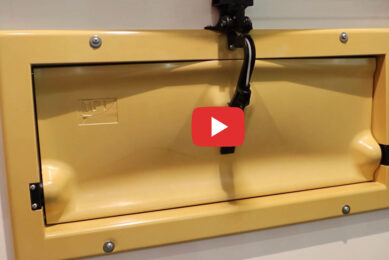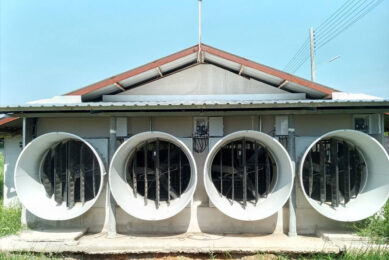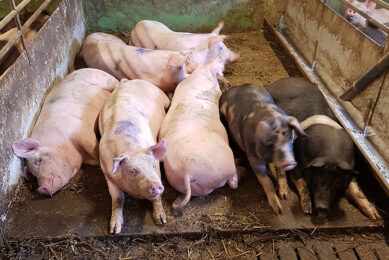Airbags in piggery ventilation (II)

Last month I outlined the usefulness of this under-recognised system. Here are some easy to follow principles.
- The airbag (i.e. the duct) diameter should match the diameter of the fan. Ordinary propeller fans are sufficient, but use the higher speeds available as this ensures firm inflation and a good throw of air.
- Use heavy gauge polyfilm. 500 gauge upwards.
- Important: Taper the duct -this allows the size of the exit holes down its length to be uniform. When laid out flat , ratios of widths at wide to narrow ends should be 3:1 for up to 25 m, 2:1 for 25-50 m, 1.5:1 for 50-70 m, and no taper above 70 m. The narrow end is of course sealed.
- Along the taper, staple at 40 mm intervals and seal with ‘ducktape’. The surplus material then forms a flat ‘fin’ which can support the rest of the duct from the ceiling, see Figure 1.
- Important: Calculate the number of exit holes (called ‘sipes’) needed. Total area of holes down the length of one duct should equal 1.8 times the cross-sectional area of the fan.
- Hole size: Too few holes prevent the fan from delivering its full capacity. Too many prevent the duct from inflating fully and destroys air placement, so follow the formula in point 5 above. Diameters greater than 40 mm give directional jets and 30 mm or less, diffused jets. A 600 mm hole size is most common and gives a good throw of air, but half this or less is advisable for small pigs. For widespan yards with grouped sows, 800 mm holes are better with 1,200 rpm fans.
- Important: The holes are cut ‘D’ shaped, with the flap downstream, this prevents the exit air having a forward direction, see Figures 2 and 3.
- Ideally the holes should be spaced differently (not sized differently) down the duct. This is because more air, not less, is discharged furthest away from the fan. This can be counteracted by dividing the length of the duct by the number of holes, see above. Then the spacing at the far, closed, end is made one-third of the average spacing, and the spacing towards the fan two-thirds of the average, with holes in between cut to proportionate spacing. In practice producers tell me that this is too ‘fiddly’ and report an even-enough air flow if the tapering of the duct is done correctly, see point 3. Thankfully, in large widespans with duct lengths of 45 m or more (don’t exceed 85 m) the holes can be evenly spaced down the duct as friction counterbalances the tendency for more air to be discharged at the sealed, far end of the duct.
- Decide on the direction required for the jets and the number of rows of holes – for example if two are needed to ventilate pens on both sides of an access passage. Remember that by rotating the fixing clamp to the air straightener, the rows of holes can be positioned to give different air directions. A flexible arrangement if required and useful if you change your mind.
- Air straightener – made from sheet metal. Length equal to twice the fan diameter. While a simple internal cross of four radial vanes is usually adequate, some people prefer eight. A simple welding job. The vanes need not meet in the centre if this helps the welding process. Loosening a large ‘jubilee clip’ hinged clamping device enables the duct to be rotated and re-clamped to give a choice of air patterns towards the pigs if the duct is supported by rings (best), or twine.
- Air outlets. Total area 2 to 3 times that of the inlet ducts, depending how airtight is the building.
[([002_boerderij-image-1558190.jpeg]:inzetgroot)]
Figures 1-3
Not difficult, and the cheapest of all forced ventilation systems. Good luck with it!
[Source: Pig Progress magazine Vol 30 nr 2, 2014 – ‘What the textbooks don’t tell you about…’ series]











